Related Research Articles

Macaws are a group of New World parrots that are long-tailed and often colorful, in the tribe Arini. They are popular in aviculture or as companion parrots, although there are conservation concerns about several species in the wild.

The palm cockatoo, also known as the goliath cockatoo or great black cockatoo, is a large smoky-grey or black parrot of the cockatoo family native to New Guinea, Aru Islands, and Cape York Peninsula in Queensland, Australia. It has a very large black beak and prominent red cheek patches.

Spix's macaw, also known as the little blue macaw, is a macaw species that was endemic to Brazil. It is a member of tribe Arini in the subfamily Arinae, part of the family Psittacidae. It was first described by German naturalist Georg Marcgrave, when he was working in the State of Pernambuco, Brazil in 1638 and it is named for German naturalist Johann Baptist von Spix, who collected a specimen in 1819 on the bank of the Rio São Francisco in northeast Bahia in Brazil. This bird has been completely extirpated from its natural range, and following a several-year survey, the IUCN officially declared it extinct in the wild in 2019. However, after over 20 years of conservation efforts, 200 macaws have been bred from just two parent birds, and 52 individual birds have since been reintroduced into their natural environment in June 2022.

The scarlet macaw is a large yellow, red and blue Neotropical parrot native to humid evergreen forests of the Americas. Its range extends from southeastern Mexico to Peru, Ecuador, Colombia, Bolivia, Venezuela and Brazil in lowlands of 500 m (1,600 ft) up to 1,000 m (3,300 ft), the Caribbean island of Trinidad, as well as the Pacific island of Coiba. Formerly, the northern extent of its range included southern Tamaulipas. In some areas, it has suffered local extinction because of habitat destruction, or capture for the parrot trade, but in other areas, it remains fairly common. It is the national bird of Honduras. Like its relative the blue-and-yellow macaw, the scarlet macaw is a popular bird in aviculture as a result of its striking plumage.

The orange-bellied parrot is a small parrot endemic to southern Australia, and one of only three species of parrot that migrate. It was described by John Latham in 1790. A small parrot around 20 cm (8 in) long, it exhibits sexual dimorphism. The adult male is distinguished by its bright grass-green upper parts, yellow underparts and orange belly patch. The adult female and juvenile are duller green in colour. All birds have a prominent two-toned blue frontal band and blue outer wing feathers.
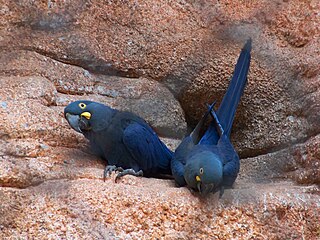
Lear's macaw, also known as the indigo macaw, is a large all-blue Brazilian parrot, a member of a large group of neotropical parrots known as macaws. It was first described by Charles Lucien Bonaparte in 1856. Lear's macaw is 70–75 cm long and weighs around 950 g. It is coloured almost completely blue, with a yellow patch of skin at the base of the heavy, black bill.
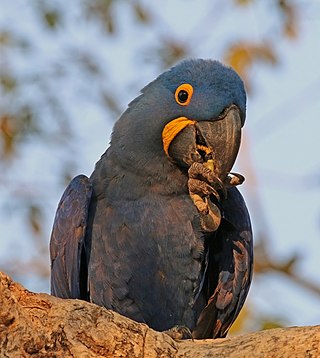
The hyacinth macaw, or hyacinthine macaw, is a parrot native to central and eastern South America. With a length of about one meter it is longer than any other species of parrot. It is the largest macaw and the largest flying parrot species; the flightless kākāpō of New Zealand outweighs it at up to 3.5 kg. While generally easily recognized, it could be confused with the smaller Lear's macaw. Habitat loss and the trapping of wild birds for the pet trade have taken a heavy toll on their population in the wild, so the species is classified as Vulnerable on the International Union for Conservation of Nature's Red List, and it is protected by its listing on Appendix I of the Convention on International Trade in Endangered Species of Wild Fauna and Flora (CITES).

The blue-throated macaw, also known as the Caninde macaw or Wagler's macaw, is a macaw endemic to a small area of north-central Bolivia, known as Los Llanos de Moxos. In 2014 this species was designated by law as a natural patrimony of Bolivia. Until 2010, it was hunted by native people to make feathered "Moxeño" headdresses for "machetero" ritual dances.
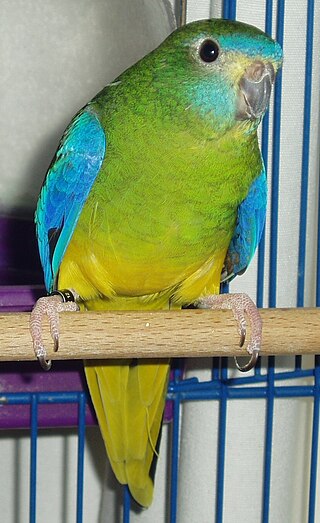
The genus Neophema is an Australian genus with six or seven species. They are small, dull green parrots differentiated by patches of other colours, and are commonly known as grass parrots. The genus has some sexual dichromatism, with males having brighter hues.

The red-shouldered macaw (Diopsittaca nobilis) is a small green South American parrot, a member of a large group of Neotropical parrots called macaws. The species is named for the red coverts on its wings. It is the smallest macaw, being 30–35 cm (12–14 in) in length - similar in size to the Aratinga parakeets. It is native to the tropical lowlands, savannah, and swamplands of Brazil, the Guianas, Bolivia, Venezuela, and far south-eastern Peru. There are three subspecies: The noble macaw(Diopsittaca nobilis cumanensis), Hahn's macaw(Diopsittaca nobilis nobilis), and the long-winged macaw(Diopsittaca nobilis longipennis). The long-winged macaw is a poorly distinct third subspecies that has longer wings, but is otherwise similar to the noble macaw. The Hahn's subspecies is named for German zoologist Carl-Wilhelm Hahn, who in 1834 began compiling Ornithologischer Atlas oder naturgetreue Abbildung und Beschreibung der aussereuropäischen Vögel (Engl: Ornithological Atlas or natural depiction and description of birds from outside Europe).

Loro Parque or 'Loro Park' is a 135,000 m2 zoo on the outskirts of Puerto de la Cruz on Tenerife, Spain where it houses an extensive and diverse reserve of animal and plant species. The park was conceived as a paradise for parrots and has developed over the years into one of the biggest attractions of the Canary Islands, with over 40 million visitors.
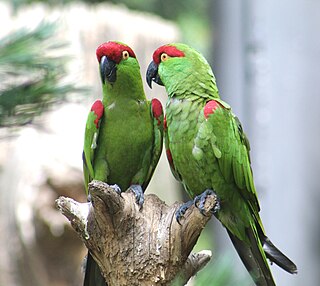
The thick-billed parrot is a medium-sized parrot endemic to Mexico that formerly ranged into the southwestern United States. Its position in parrot phylogeny is the subject of ongoing discussion; it is sometimes referred to as thick-billed macaw or thick-billed conure. In Mexico, it is locally called guacamaya ("macaw") or cotorra serrana. Classified internationally as Endangered through IUCN, the thick-billed parrot's decline has been central to multiple controversies over wildlife management. In 2018, the estimated wild population in Mexico was 1,700.

The blue-winged macaw, in aviculture more commonly known as Illiger's macaw, is a species of small macaw found in central and eastern South America. The second name is in honor of the German ornithologist Johann Karl Wilhelm Illiger. It was previously placed in the genera Ara or Propyrrhura. Blue-winged macaws have been known to reach an age of 50–60 years.
Tony Silva, also known as Antonio H. Silva is an American aviculturist and ornithologist, and the author of books and articles about parrots. From 1989 to 1992, he was curator of birds at Loro Parque, the largest parrot park in the world. In 1996, he was convicted of conspiring to smuggle rare parrots into the United States and of tax evasion.
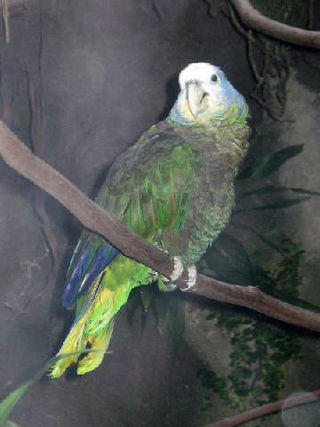
The Funds for Endangered Parrots (FbP) is a German non-governmental organisation (NGO) in the field of species conservation, which supports and operates projects worldwide for endangered parrot species.
Antonio de Dios is a "bird aficionado" known in the relevant circles from the Philippines who established in 1975 Birds International, Inc., a company working in the field of aviculture.
Rosemary Low is a British aviculturist, ornithologist, conservationist, writer and expert on parrots.

The international trade in parrots is a lucrative enterprise, and forms an important part of the international wildlife trade. As parrots have become increasingly endangered, many countries have placed restrictions on the trade and/or prohibited the trade altogether. Despite the restriction on trade in many countries however, the market still operates both legally and illegally. A big factor that attempts to keep the control in international trade is CITES. The Convention of International Trade in Endangered Species of Wildlife Fauna and Flora was established in 1975, and consists of 184 parties which includes 183 countries along with the European Union. CITES offers three different degrees of protection for around 38,000 species around the world.
The American Federation of Aviculture, Inc. (AFA) is a national organization dedicated to aviculture, whose purpose is to educate the public and assist members regarding best practices for keeping and living with exotic birds. Local affiliate bird clubs throughout the United States, including Puerto Rico, along with national and international specialty organizations; comprise the Federation. The American Federation of Aviculture is registered as a non-profit 501(c)3 educational organization, with a business office located in Austin, Texas.

Hybrid macaws are the product of cross breeding of more than one species of macaw, resulting in a hybrid. They are often characterized and bred for their unique and distinct coloring, and for this reason, are highly sought after and valued in the exotic pet trade. Macaws are native to tropical North and South America. Hybridization of macaws occurs both in nature and captivity, being one of the few species that can produce viable, fertile offspring unlike many other hybrids produced from crossing different species resulting in sterile hybrids with factors that limit their success of survival. Hybrid macaws do not hold any scientific names, and are often labeled by the two macaw species they are produced from
References
- 1 2 3 "Birds International, Inc. - About Us". Archived from the original on 2008-08-21. Retrieved 2008-07-20.
- ↑ Harrison, Greg J. 2000. "Extraordinary... The Birds International, Inc.". HBD's Avian Examiner 18. Available from the WWW: "Archived copy" (PDF). Archived from the original (PDF) on 2008-07-04. Retrieved 2008-07-20.
{{cite web}}: CS1 maint: archived copy as title (link) - ↑ "janeczek.com". Archived from the original on 15 May 2008. Retrieved 18 December 2021.
- ↑ "Public Aviaries". Archived from the original on 2008-06-21. Retrieved 2008-07-20.
- ↑ "Birds International Inc". Archived from the original on 2009-09-10. Retrieved 2008-07-20.
- 1 2 3 4 Goodwill Birds Training. "A World-Class Breeding Center". "Birds International Inc". Archived from the original on 2008-06-15. Retrieved 2008-07-20.
- ↑ Pangyarihan, Gilbert. 2007. "A Million Violins Singing Out of the Boondocks: Violins made of Philippine tropical woods." Business in Development Network. Available from the WWW: "Business in Development Network - A Million Violins Singing Out of the Boondocks". Archived from the original on 2008-07-11. Retrieved 2008-07-20.
- ↑ Parliament of Australia. Senate Rural and Regional Affairs and Transport Committee. Commercial Utilisation of Australian Native Wildlife Chapter 13 - Aviculture (Birds). 13.55. Available from the WWW: "Parliament of Australia: Senate: Committee: Commercial Utilisation of Australian Native Wildlife". Archived from the original on 2008-08-23. Retrieved 2008-07-20.
- ↑ Wilson, G. R. (1997). Keith Hyde (ed.). "Native birds and reptiles". New Rural Industries: A Handbook for Farmers and Investors: 61. Archived from the original on 2008-07-22. Retrieved 2008-07-22.
- ↑ ""AMIANAN", THE RESCUED PHILIPPINE EAGLE DIES OF INFECTION". Newsflash.org. Archived from the original on 3 March 2016. Retrieved 18 December 2021.
- ↑ "PHILIPPINE EAGLE 'AMIANAN' GETS STUFFED IN LOS BANOS". Newsflash.org. Retrieved 18 December 2021.
- ↑ "Register of captive-breeding operations | CITES". Cites.org. Retrieved 18 December 2021.
- ↑ "List Export on Captive Bred Birds from BII". Archived from the original on 13 May 2008. Retrieved 18 December 2021.
- 1 2 [ dead link ]
- ↑ "WORLDTWITCH - Spix's Macaw, Cyanopsitta spixii Now Extinct in the Wild". Worldtwitch.com. Retrieved 18 December 2021.
- ↑ "Parrots and Profits - National Zoo| FONZ". 7 August 2008. Archived from the original on 2008-08-07. Retrieved 18 December 2021.
- ↑ "Saving Species - Spix's Macaw Recovery Project". Bluemacaws.org. Retrieved 18 December 2021.
- ↑ Schischakin, Natasha (2003). ""The Spix's Macaw... Can It Survive the Politics of Conservation? A personal perspective on the efforts to save one of the world's most endangered species... and the controversy that surrounds it"" (PDF). Proceedings of the International Aviculturists Society.
- ↑ "The Spix's Macaw Conservation Program - a Non-Extinction Story With Permission from AFA and Natasha Schischakin, Conservation Coordinator, Houston Zoo, Houston, TX". "The Spix's Macaw Conservation Program". Archived from the original on 2008-09-16. Retrieved 2008-07-21.
- ↑ "ASP Test Page". Arabrasil.org. Retrieved 18 December 2021.
- ↑ "Managing the world's largest population of Spix's Macaws". Bluemacaws.org. Retrieved 18 December 2021.
- ↑ "Battle of the bird breeders". Bluemacaws.org. Retrieved 18 December 2021.
- ↑ Juniper, Tony. 2003. Spix's Macaw: The Race to Save the World's Rarest Bird. Atria: Ch. 10 (pp 201-230).
- ↑ Boussekey, Marc (1995). "Conservation of the Red-Vented Cockatoo" (PDF). PsittaScene Magazine. Vol. 7.4 (no. 25). p. 7.
- ↑ Boussekey, M. 2007. "An integrated approach to conservation of the Philippine or Red-vented cockatoo: Cacatua haematuropygia". International Zoo Yearbook 37 (1): pp. 137-146.
- ↑ M. A. R. (1996). "Protocol for red-vented cockatoo at Birds International Inc., Philippines" in European studbook for the red-vented cockatoo
- 1 2 3 "Register of captive-breeding operations". Cites.org. Retrieved 18 December 2021.
- ↑ CITES. Fourteenth meeting of the Conference of the Parties The Hague (Netherlands), 3–15 June 2007. List of participants - Observers. "Archived copy" (PDF). Archived from the original on 2008-11-13. Retrieved 2008-07-20.
{{cite web}}: CS1 maint: archived copy as title (link) CS1 maint: bot: original URL status unknown (link) - ↑ CITES. Twenty-third meeting of the Animals Committee Geneva (Switzerland), 19–24 April 2008. List of participants. "Archived copy" (PDF). Archived from the original (PDF) on 2008-11-16. Retrieved 2008-07-20.
{{cite web}}: CS1 maint: archived copy as title (link) - ↑ CITES. SC57 Doc. 40.2. Fifty-seventh meeting of the Standing Committee Geneva (Switzerland), 14–18 July 2008. Reports. Reports of regional representatives. "Archived copy" (PDF). Archived from the original (PDF) on 2008-12-05. Retrieved 2008-07-20.
{{cite web}}: CS1 maint: archived copy as title (link) - ↑ Humane Society International. 2007, June 14. "United Nations Refuses Permission for Captive Breeding Operation for Eight Endangered Birds". "United Nations Refuses Permission for Captive Breeding Operation for Eight Endangered Birds | Humane Society International". Archived from the original on 2008-10-28. Retrieved 2008-07-20.